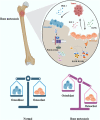Research progress of bone metastases: From disease recognition to clinical practice
- PMID: 36761418
- PMCID: PMC9905420
- DOI: 10.3389/fonc.2022.1105745
Research progress of bone metastases: From disease recognition to clinical practice
Abstract
Bone metastases, as one of the common types of metastatic tumors, have a great impact on the survival period and quality of life of patients. Bone metastases are usually characterized by bone destruction. Skeletal related events caused by bone destruction often lead to pain, pathological fractures and even paralysis. In this review, we provide a detailed explanation of bone metastases from the epidemiology, clinical features, pathogenesis, and recently developed clinical treatment viewpoints. We concluded that the incidence of bone metastases is increasing gradually, with serious clinical symptoms, complex pathogenesis and diverse clinical treatment. Tumor cells, immune cells, osteoblasts/osteoclasts and other cells as well as cytokines and enzymes all play a key role in the pathogenesis of bone metastases. We believe that the future treatment of bone metastases will be diversified and comprehensive. Some advanced technologies, such as nanomedicine, could be used for treatment, but this depends on understanding how disease occurs. With the development of treatment, the survival time and quality of life of patients will be improved.
Keywords: bone metastases; clinical practice; disease recognition; review; scope.
Copyright © 2023 Yang, Pan, Huang, Hu and Shao.
Conflict of interest statement
The authors declare that the research was conducted in the absence of any commercial or financial relationships that could be construed as a potential conflict of interest.
Figures




Similar articles
-
Early detection of bone metastases of hepatocellular carcinoma reduces bone fracture and paralysis.Jpn J Clin Oncol. 2019 Jun 1;49(6):529-536. doi: 10.1093/jjco/hyz028. Jpn J Clin Oncol. 2019. PMID: 30957835
-
Examination of the mechanisms of osteolysis in patients with metastatic breast cancer.Oncol Rep. 2009 May;21(5):1153-9. doi: 10.3892/or_00000335. Oncol Rep. 2009. PMID: 19360288
-
Cancer bone metastases and nanotechnology-based treatment strategies.Expert Opin Drug Deliv. 2022 Oct;19(10):1217-1232. doi: 10.1080/17425247.2022.2093856. Epub 2022 Jul 3. Expert Opin Drug Deliv. 2022. PMID: 35737871 Review.
-
Bone metastases in non-small cell lung cancer: a narrative review.J Thorac Dis. 2022 May;14(5):1696-1712. doi: 10.21037/jtd-21-1502. J Thorac Dis. 2022. PMID: 35693589 Free PMC article. Review.
-
Role of bone-anabolic agents in the treatment of breast cancer bone metastases.Breast Cancer Res. 2014;16(6):484. doi: 10.1186/s13058-014-0484-9. Breast Cancer Res. 2014. PMID: 25757219 Free PMC article. Review.
Cited by
-
Assessment of chemical-shift and diffusion-weighted magnetic resonance imaging in differentiating malignant and benign vertebral lesions in oncologic patients. A single institution experience.Radiol Oncol. 2024 Oct 4;58(4):527-534. doi: 10.2478/raon-2024-0049. eCollection 2024 Dec 1. Radiol Oncol. 2024. PMID: 39361940 Free PMC article.
-
Clinical efficacy analysis of surgical treatment for spinal metastasis under the multidisciplinary team using the NOMS decision system combined with the revised Tokuhashi scoring system: a randomized controlled study.J Orthop Surg Res. 2024 Mar 21;19(1):195. doi: 10.1186/s13018-024-04668-1. J Orthop Surg Res. 2024. PMID: 38515197 Free PMC article. Clinical Trial.
-
Biomarker-Driven Approaches to Bone Metastases: From Molecular Mechanisms to Clinical Applications.Biomedicines. 2025 May 10;13(5):1160. doi: 10.3390/biomedicines13051160. Biomedicines. 2025. PMID: 40426987 Free PMC article. Review.
-
Immunotherapy in the Battle Against Bone Metastases: Mechanisms and Emerging Treatments.Pharmaceuticals (Basel). 2024 Nov 26;17(12):1591. doi: 10.3390/ph17121591. Pharmaceuticals (Basel). 2024. PMID: 39770433 Free PMC article. Review.
-
Long non-coding RNAs in bone metastasis: progresses and perspectives as potential diagnostic and prognostic biomarkers.Front Endocrinol (Lausanne). 2023 Apr 17;14:1156494. doi: 10.3389/fendo.2023.1156494. eCollection 2023. Front Endocrinol (Lausanne). 2023. PMID: 37143733 Free PMC article. Review.
References
Publication types
LinkOut - more resources
Full Text Sources

